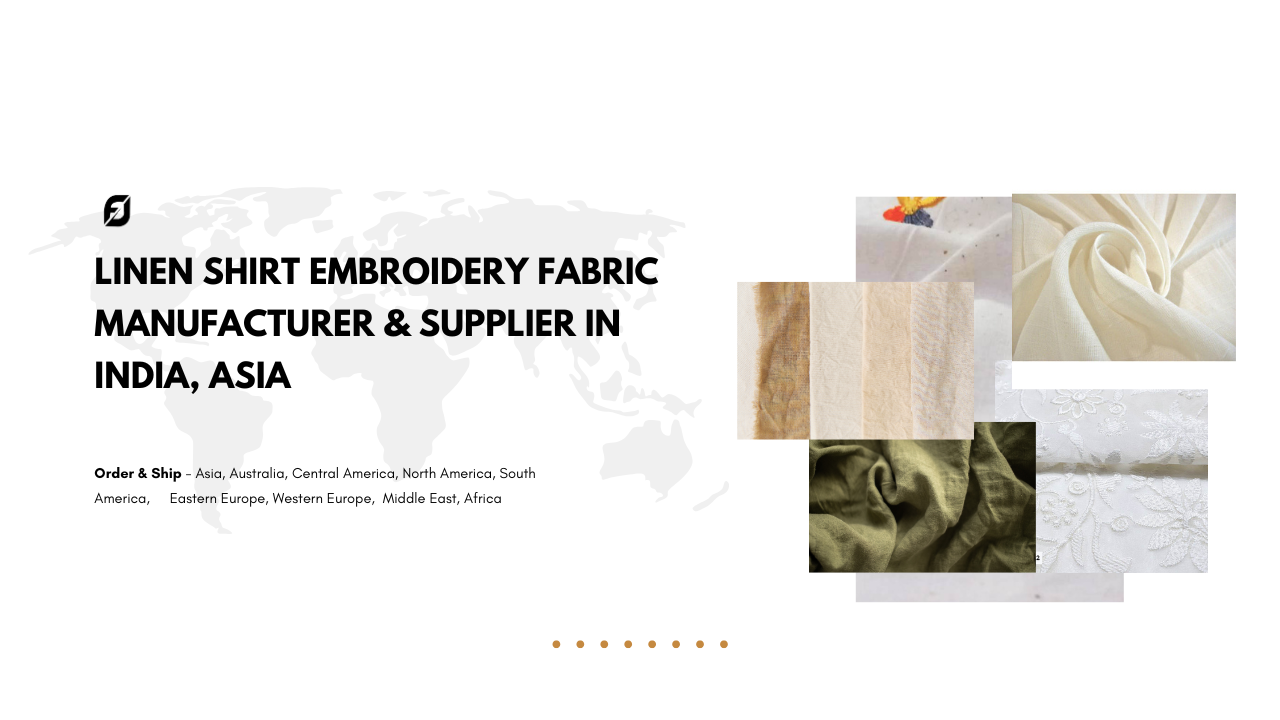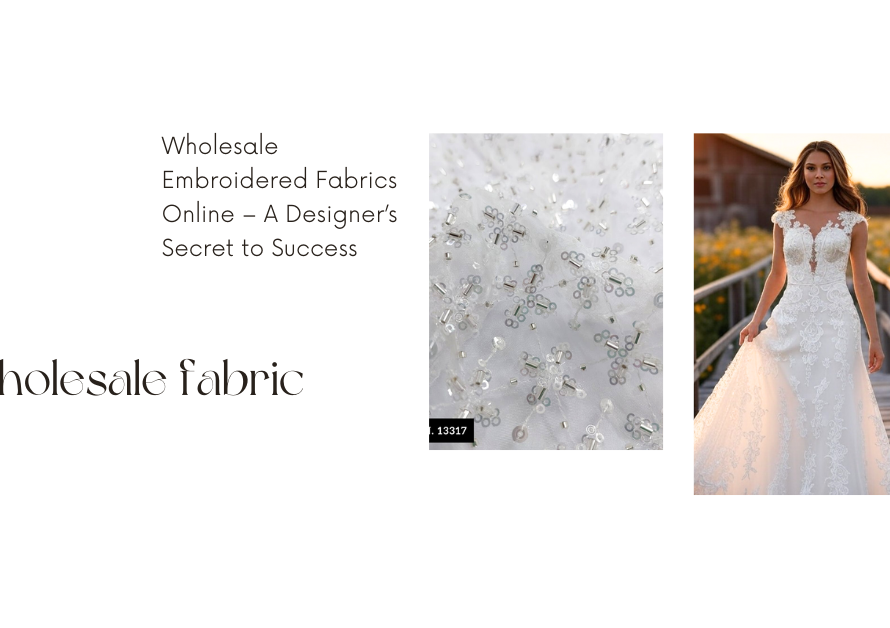Santoon fabric, known for its luxurious texture and versatility, has become a favorite in the fashion industry for creating a wide range of garments.
This article delves into the details of Santoon fabric, its types, the kinds of apparel that can be made from it, the scope for heavy embroidery, and its growing popularity across the globe, including Madhav Fashion’s role in its success.
Viscose Row Silk Satin Embroidery Fabric: Luxurious & Versatile for All Garments
What is Santoon Fabric?
Santoon fabric is a synthetic fabric made from polyester or a polyester blend. Known for its soft, silky texture, Santoon is lightweight yet durable, making it an excellent choice for creating both fashionable and functional garments. The fabric has a shiny appearance, giving it a luxurious feel, while also being breathable and stretchable, making it comfortable to wear for long periods.
Types of Santoon Fabric
Santoon fabric comes in various types depending on its weave and finish. The main variations include:
- Plain Santoon: A smooth, untextured version ideal for linings and simple garments.
- Stretchable Santoon: A variant that offers more flexibility, making it suitable for body-hugging outfits.
- Printed Santoon: Features printed designs, suitable for trendy garments like kurtas and dresses.
- Embroidery Santoon: This is specifically crafted to accommodate detailed embroidery work, providing a smooth base for heavy and intricate designs.
Apparel Made from Santoon Fabric
Santoon is highly versatile and is used to make various types of apparel, including:
- Kali and Lehenga: Santoon is perfect for creating traditional, flowy garments like kalis and lehengas, where its smooth texture complements the elaborate designs.
- Anarkali Suits: The fabric’s softness and drapability make it ideal for Anarkali suits, which require a blend of structure and fluidity.
- Sarees: Santoon is often used to create sarees with intricate embroidery, adding elegance to the drape.
- Lining Fabric: Due to its smooth finish, Santoon is frequently used as a lining in garments like sarees, lehengas, and jackets to provide comfort and structure.
Can Heavy Embroidery Be Done on Santoon Fabric?
Yes, heavy embroidery can be done on Santoon fabric. Its smooth, consistent surface provides an excellent base for a wide range of embroidery techniques. From all-over embroidery to intricate zari work, Santoon can support heavy embellishments without compromising on comfort. Embroidery patterns such as Kali, Daman, Butta, and sequins work are particularly well-suited for Santoon. The fabric’s durability ensures that even with heavy embroidery, it retains its strength and doesn’t tear easily.
Types of Garments Made from Santoon Embroidery Fabric
Santoon embroidery fabric is popular for creating the following garments:
- Lehengas and Anarkalis: With elaborate embroidery, these traditional garments gain a luxurious appeal.
- Sarees: Embroidered Santoon sarees are a popular choice for festive and formal occasions.
- Gowns and Dresses: The fabric’s smooth texture and ability to hold embroidery make it ideal for creating stunning gowns and cocktail dresses.
- Sherwanis and Kurta Pajamas: For menswear, embroidered Santoon is used to create sherwanis and kurtas, giving them a regal look.
In addition, Santoon fabric is widely used in linings, giving structure and comfort to garments like lehengas, sarees, and jackets.
Popularity of Santoon Embroidery Fabric
Currently, Santoon embroidery fabric is in high demand in India as well as internationally. It is particularly popular in fashion-forward cities such as:
- India: Mumbai, Delhi, Kolkata, and Jaipur are major markets for Santoon embroidery fabric, where it is used in wedding and festive attire.
- International Markets: Santoon embroidery fabric is highly favored in countries like the USA, UK, UAE, and South Africa, where Indian and ethnic fashion trends have a growing presence.
Madhav Fashion, as one of the largest manufacturers of Santoon embroidery fabric, has seen significant success in exporting this fabric to international markets, where it is used by top designers and boutiques.
Is Santoon Fabric Dyeable? Difference Between Dyeable, Color, and Digital Print Santoon
Yes, Santoon fabric is dyeable. It is available in various forms:
- Dyeable Santoon: This is uncolored Santoon fabric, which can be dyed into various shades as per the customer’s requirements.
- Colored Santoon: This version comes pre-colored in a variety of hues and is ready for garment production.
- Digital Print Santoon: This variant features digital prints that are directly transferred onto the fabric, offering detailed patterns and vibrant designs.
The key difference between dyeable, colored, and digital print Santoon lies in the flexibility and customization options. Dyeable Santoon allows for a personalized color palette, while colored Santoon is pre-set, and digital prints provide more intricate designs.
Why Choose Madhav Fashion’s Santoon Embroidery Fabric?
Madhav Fashion is a leader in producing high-quality Santoon embroidery fabric, which is loved in both domestic and international markets. Their collection is known for its vibrant colors, intricate embroidery, and superior craftsmanship. Madhav Fashion’s Santoon fabric is popular not just in India but in countries across the globe, including the USA, UK, UAE, Australia, and Singapore.
Their ability to offer customization, such as dyeing and embroidery options, sets them apart from competitors. Whether you’re looking for Kali, Lehenga, Saree, Anarkali, or Sherwani fabric, Madhav Fashion provides a wide range of options to suit every need.
Santoon embroidery fabric offers endless possibilities for creating stylish and elegant apparel. From traditional Indian wear like lehengas and Anarkalis to modern gowns and dresses, Santoon’s soft texture and compatibility with heavy embroidery make it a preferred fabric among designers. With Madhav Fashion’s extensive range of Santoon fabrics, the possibilities are limitless, whether you’re crafting beautiful garments for local or international markets.
Santoon fabric continues to shine in the fashion world, and its popularity is set to grow further, thanks to its luxurious feel, versatility, and embroidery-friendly nature.
__________________________________________________
What is Santoon Fabric and Why is it Popular?
Santoon fabric is a synthetic textile made primarily from polyester or a polyester blend, known for its silky smooth texture and slight stretch. It is popular in the fashion industry due to its luxurious feel, durability, and versatility. The fabric is lightweight, breathable, and has a subtle shine, making it suitable for both casual and formal wear. It’s often used in traditional Indian outfits like lehengas, Anarkali suits, sarees, and gowns, where comfort and elegance are key. The fabric’s ability to hold various forms of embroidery and embellishments enhances its appeal, particularly for festive and wedding attire.
Furthermore, its affordability compared to natural fabrics like silk makes Santoon a go-to option for mass production of high-fashion clothing. Designers and garment manufacturers choose Santoon because it is easy to work with, doesn’t wrinkle easily, and retains its shape well. These characteristics, along with its stretch and shine, make it a favored choice for linings and inner layers of dresses and lehengas. Overall, its balance of luxury, comfort, and cost-effectiveness contributes to Santoon fabric’s growing popularity in both local and international fashion markets.
What Are the Different Types of Santoon Fabric Available?
Santoon fabric comes in several varieties, each tailored to specific uses. The most common types include:
- Plain Santoon: A basic, smooth version often used as a lining material in garments like sarees, lehengas, and jackets. It’s also used for making simple, everyday wear outfits.
- Stretchable Santoon: This type has a slight elasticity, making it ideal for body-hugging garments like dresses and gowns. Its stretch factor ensures that the fabric provides both comfort and a flattering fit.
- Printed Santoon: Features digitally or screen-printed patterns, adding an aesthetic appeal suitable for kurtas, dresses, and casual wear.
- Embroidery Santoon: Specifically designed to support heavy embellishments and intricate embroidery work. It is favored in the creation of bridal and festive wear. Each type serves different fashion needs, with embroidery Santoon being the most popular for making ornate, heavily decorated attire like lehengas, sarees, and Anarkali suits.
What Kind of Apparel Can Be Made from Santoon Embroidery Fabric?
Santoon embroidery fabric is incredibly versatile and is used to create a variety of traditional and modern garments. Some of the most popular types of apparel include:
- Lehengas: Heavily embroidered Santoon fabric is often used to create elegant lehengas for weddings and festive occasions.
- Anarkali Suits: Santoon’s soft, flowy texture is ideal for crafting Anarkali suits, which require a fabric that drapes well and complements intricate embroidery.
- Sarees: Santoon sarees, often embellished with sequins or intricate embroidery, are popular for formal events and traditional functions.
- Gowns: Embroidered Santoon fabric is also used to make luxurious gowns and cocktail dresses for evening wear.
- Sherwanis and Kurta Pajamas: Santoon embroidery fabric is also used for men’s ethnic wear like sherwanis, giving them a regal and elegant appearance. Additionally, Santoon is widely used in linings, adding structure and comfort to various garments.
Can Heavy Embroidery Be Done on Santoon Fabric?
Yes, heavy embroidery can be easily done on Santoon fabric. Due to its smooth texture and durability, Santoon fabric provides an excellent base for intricate and heavy embellishments. Techniques such as zari work, sequins, beads, and mirror work can all be applied to Santoon without compromising the fabric’s integrity. The fabric’s strength ensures that it can handle the weight of elaborate embroidery patterns, such as all-over designs, butta work, and floral motifs.
This makes it an ideal choice for festive and bridal wear, where ornate details are highly valued. Moreover, Santoon can also handle other forms of embellishments, such as cutwork and patchwork, adding versatility to its application. Whether it’s traditional Kali designs for lehengas or intricate borders for sarees, Santoon holds up well, maintaining both comfort and aesthetic appeal. The fabric’s ability to support heavy embroidery without tearing or losing its shape is a key reason why it is favored by designers and garment manufacturers.
Is Santoon Fabric Dyeable, and How Does It Differ from Colored or Digital Print Santoon?
Yes, Santoon fabric is dyeable, which means it can be custom-dyed to match any color requirements. Dyeable Santoon is typically used by designers and manufacturers who need specific color palettes for their garments. This type of fabric allows for flexibility in design and can be dyed using various techniques.
- Dyeable Santoon: Comes in an undyed, neutral state and can be colored as per the user’s choice. It is ideal for custom clothing production.
- Colored Santoon: Pre-dyed in specific shades and ready for immediate use in garment manufacturing. It saves time for designers who require standardized colors.
- Digital Print Santoon: Features printed designs that are digitally transferred onto the fabric. This allows for intricate patterns and vibrant colors, making it suitable for trendy, fashion-forward garments. The main difference between these types lies in customization and production efficiency. Dyeable Santoon offers more flexibility, while colored and digital print versions cater to quick production with standardized aesthetics.
Where is Santoon Embroidery Fabric Most Popular in the World?
Santoon embroidery fabric enjoys global popularity, particularly in countries with a strong demand for Indian ethnic and festive wear.
- India: The fabric is widely used in major fashion hubs like Mumbai, Delhi, Kolkata, and Jaipur, where it is used in the production of bridal and festive attire.
- United States and Canada: Indian diaspora communities in these countries have a growing demand for Santoon embroidery fabric, especially for traditional weddings and cultural events.
- United Kingdom: With a large South Asian community, the UK has a high demand for Indian fabrics like Santoon, especially for creating sarees, lehengas, and Anarkali suits.
- United Arab Emirates: Dubai and Abu Dhabi are major centers for high-end Indian fashion, and Santoon fabric is frequently used in luxury ethnic wear collections.
- South Africa: Indian ethnic wear is popular among the Indian-origin population, making Santoon fabric a sought-after material for traditional outfits. Santoon’s versatility and affordability contribute to its popularity across these regions.
How is Santoon Fabric Used in Linings?
Santoon fabric is widely used as a lining material in various garments due to its smooth texture and durability. In traditional wear like lehengas, sarees, and Anarkali suits, Santoon lining adds a layer of comfort and enhances the overall structure of the garment. Its stretchable quality also ensures that the garment retains its shape while allowing ease of movement for the wearer. Additionally, Santoon linings are used in gowns and jackets, providing a seamless inner layer that feels soft against the skin.
For designers and manufacturers, Santoon is an excellent choice for linings because it is lightweight, doesn’t wrinkle easily, and is resistant to wear and tear. Unlike some other lining fabrics, Santoon doesn’t compromise the breathability of the garment, making it suitable for both summer and winter attire. It can also be dyed to match or contrast with the outer fabric, offering customization options. Overall, Santoon fabric is a popular choice for linings in high-end and traditional garments, providing both comfort and aesthetic appeal.
What Makes Madhav Fashion’s Santoon Embroidery Fabric Stand Out?
Madhav Fashion is one of the leading manufacturers of high-quality Santoon embroidery fabric, known for its exceptional craftsmanship and attention to detail. What sets Madhav Fashion apart is its ability to offer a wide range of Santoon fabric options, including dyeable, colored, and digitally printed versions, each tailored to meet the specific needs of designers and garment manufacturers.
Their Santoon fabric is designed to support heavy embroidery, making it ideal for bridal wear, lehengas, Anarkalis, and sarees. In addition to the variety of options, Madhav Fashion emphasizes durability and comfort, ensuring that even heavily embroidered garments remain wearable and long-lasting. Their customization facility allows clients to choose specific colors, embroidery styles, and patterns, making Madhav Fashion a go-to supplier for fashion houses, boutiques, and wholesalers. The company’s global reach, with a strong presence in countries like the USA, UK, UAE, and South Africa, speaks to the international appeal and quality of their Santoon embroidery fabric. This combination of versatility, quality, and global recognition makes Madhav Fashion a standout in the textile industry.
Why is Santoon Fabric Preferred for Bridal and Festive Wear?
Santoon fabric is highly preferred for bridal and festive wear due to its luxurious feel, versatility, and ability to hold heavy embroidery and embellishments. For bridal lehengas, Anarkalis, and sarees, Santoon provides the perfect balance of comfort and opulence.
The fabric’s smooth texture and slight stretch allow for ease of movement, which is essential for long events like weddings. Santoon’s ability to support various types of embroidery, such as zari work, sequins, and mirror work, enhances its appeal for creating heavily adorned garments. Additionally, its lightweight nature makes it more comfortable to wear compared to heavier fabrics like silk. The fabric’s durability also ensures that even after hours of wear, the garment retains its shape and looks pristine.
Brides and designers alike appreciate the fabric’s ability to hold intricate designs without tearing or losing its structure. Furthermore, Santoon’s affordability compared to other luxury fabrics makes it accessible for a wider range of bridal and festive wear collections, making it a staple in the wedding fashion industry.
What Countries Have the Highest Demand for Santoon Embroidery Fabric?
Countries with large South Asian populations or a high demand for ethnic fashion have the highest demand for Santoon embroidery fabric. These include:
- India: As the primary consumer of Santoon fabric, India’s demand spans across regions like Rajasthan, Gujarat, and Maharashtra, where traditional attire like lehengas and sarees are worn for weddings and festivals.
- United States: The growing Indian diaspora in cities like New York, Los Angeles, and Chicago has created a significant market for Santoon fabric, especially for festive and wedding attire.
- United Kingdom: With a substantial South Asian community, the UK has a high demand for Santoon embroidery fabric, particularly in cities like London, Birmingham, and Manchester.
- United Arab Emirates: The UAE, particularly Dubai, is a hub for luxury Indian fashion, where Santoon fabric is used in high-end bridal and festive collections.
- Canada and South Africa: Both countries have a growing market for Indian ethnic wear, with Santoon fabric being widely used for garments like sarees, lehengas, and Anarkali suits. These countries, along with others like Australia and Singapore, represent major markets for Santoon embroidery fabric due to the cultural significance of traditional Indian fashion.






